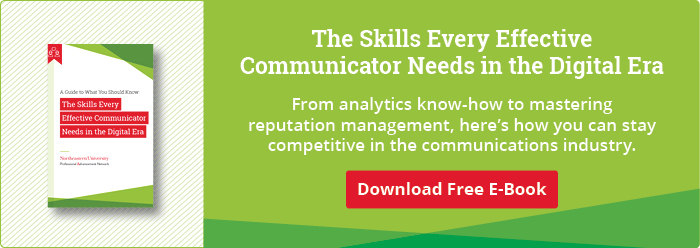If you take inventory of your closet, you’ll probably find that some of the clothing is dated, worn, or out of style. Other pieces might just need to be paired with the right accessory to be current again. Your brand strategy is similar: Every brand will date and fall out of style as businesses evolve, but the key is recognizing when it’s time for a refresh.
Strong brands share a number of attributes, according to a report from Harvard Business Review. Those brands:
- Deliver the benefits that customers truly desire
- Stay relevant
- Are properly positioned, and consistent across marketing activities
- Have managers who understand what the brand means to consumers
While it’s easy to identify when things are going well, it’s not so simple when things aren’t.
Download Our Free Guide on the Skills Every Communicator Needs in the Digital Era
From analytics know-how to reputation management, here’s how you can stay competitive.
Signs that it’s time to update your brand strategy vary, says Dr. Carl Zangerl, faculty director for Northeastern University’s Master of Science in Corporate and Organizational Communication program. Your sales might be slipping, your employees might respond differently when asked about your brand strategy, you may be moving into new markets, or the markets you’re in might be changing.
“All of these signs should make you aware that you need to be thinking about the brand identity and your position in the marketplace,” Zangerl says.
Here’s a look at five signs that your brand strategy needs a refresh—plus a look at how some companies have successfully navigated the shift.
1) There Is a Weakened—or No—Emotional Connection
Customers who feel an emotional pull toward or bond with a brand are more than twice as valuable as highly satisfied customers, according to a Harvard Business Review report. This means they’re more likely to buy and visit your store or site, aren’t as price sensitive, pay more attention to your messaging, follow your advice, and recommend you more—the perfect combination of factors that every brand desires.
When this emotional connection wanes, or disappears entirely, your brand is in trouble, Zangerl says. The most obvious sign this is happening is a dip in sales.
“When you have a strong brand identity, your external stakeholders will let you know,” he says. “They’ll be buying your product and telling their friends through word of mouth and social media.”
While that emotional connection is essential to maintain with your customers, internally, employees need to feel that connection, too.
“If my employees can articulate what the brand value proposition is, can feel that emotional connection, and can speak to it with each other and external customers, then I know I’m doing a good job of communicating the brand to my employees,” Zangerl adds. “A strong brand needs to be looked at not only externally, but internally as well.”
2) You’re Moving into New Markets
If your organization is expanding its product line or moving into new markets, it’s likely that your brand will need a refresh.
“Starbucks’ brand used to be all about coffee,” Zangerl says. “When they decided to get into a number of other product lines, like food and other kinds of beverages, they needed to reimagine and shift their branding. You need to be inclusive of what else you’re offering your customers.”
Starbucks, he adds, is a prime example of a business that has successfully reimagined itself over the years through updating its branding following mergers, trends, and forays into new markets.
Most recently, this meant simplifying its logo: It removed the “Starbucks Coffee” banner encircling the siren to signal their departure from coffee-centricity. Since its brand refresh, the company reports tremendous growth.
3) Your Market Is Changing
Fast food sandwich chain Subway learned to capitalize on America’s changing food tastes, evolving from the days of fast, easy food to healthier, more affordable alternatives. In 2016, the company announced that it planned to debut a new, cleaner logo to reflect its latest move toward cleaner food: fresh, locally grown produce that’s free of artificial preservatives.
“The market is always changing and customer preferences are always changing,” Zangerl says. “You might discover that what resonated in the marketplace in terms of brand identity isn’t resonating anymore, as Subway did.”
Subway was late to the clean eating game, however, and lost market share as a result, Zangerl adds. “They had to rethink their brand and look at sales, revenues, and social media to see what consumers are talking about to make sure their brand’s value proposition continues to resonate in the way they want it to.”
4) Your Logo Doesn’t Match Your Brand
The visual expression of your brand has to be consistent with your messaging, value proposition, and how you communicate with your internal and external stakeholders in order to be effective.
Zangerl shares one analogy: “A restaurant’s brand starts in the kitchen and is reflected in the menu. If the branding doesn’t reflect what’s being made in the kitchen, you’re not doing an effective job of branding that organization.”
Updating the company logo, for example, doesn’t need to be a drastic exercise. A number of major brands—Walmart, Microsoft, and Starbucks, for example—have evolved their logos over the years, he says. Visual elements can get dated and market shifts can require that you rethink what your brand stands for.
“It’s more about refreshing your visual identity, which doesn’t require you to change your strategy or business model,” Zangerl says. “You’re trying to make sure that the visual representation of your brand is up to date and reflects the current preferences of your customers. It can be a relatively minor change in a logo to make it look fresher and more current.”
5) Your Business Ecosystem Is Being Disrupted
The National Geographic brand has undergone a tremendous change over the past two decades—one that it didn’t necessarily seek but was forced to undertake thanks to the digital revolution.
“They were an organization whose brand was really identified by the magazine,” Zangerl says. “They had to reinvent themselves for the digital era, where so much content is delivered digitally. When you’re talking about something disrupting your core business model, that’s a driver of change. It’s not so much that your consumers are changing, your whole business ecosystem is being disrupted.”
For National Geographic, that meant moving beyond its flagship magazine and embracing the internet, social media, and television.
Disruption has affected other business models, too.
“You’ve got the Ubers and Amazons and Googles of the world that are disrupting very big economic sectors,” Zangerl says. “That disruption forces you, as an organization, to think about how you’ll not only address and adapt to the disruption, but what it means for your brand moving forward.”







Related Articles
Faculty Insights: What Do Employers Look for in a New Candidate?
Virtual Co-op Evolves Into a Social Platform WomenVotes.org
Why You Should Consider a Career in Technical Writing